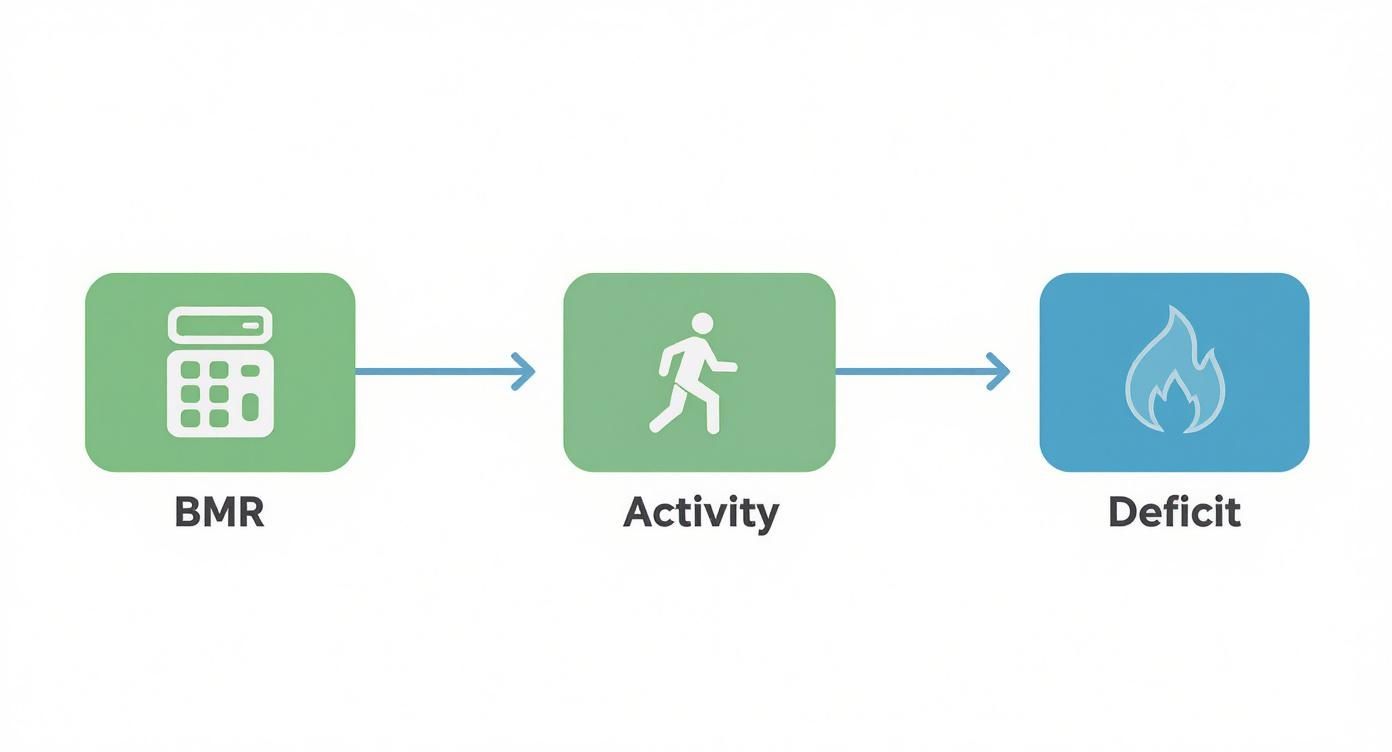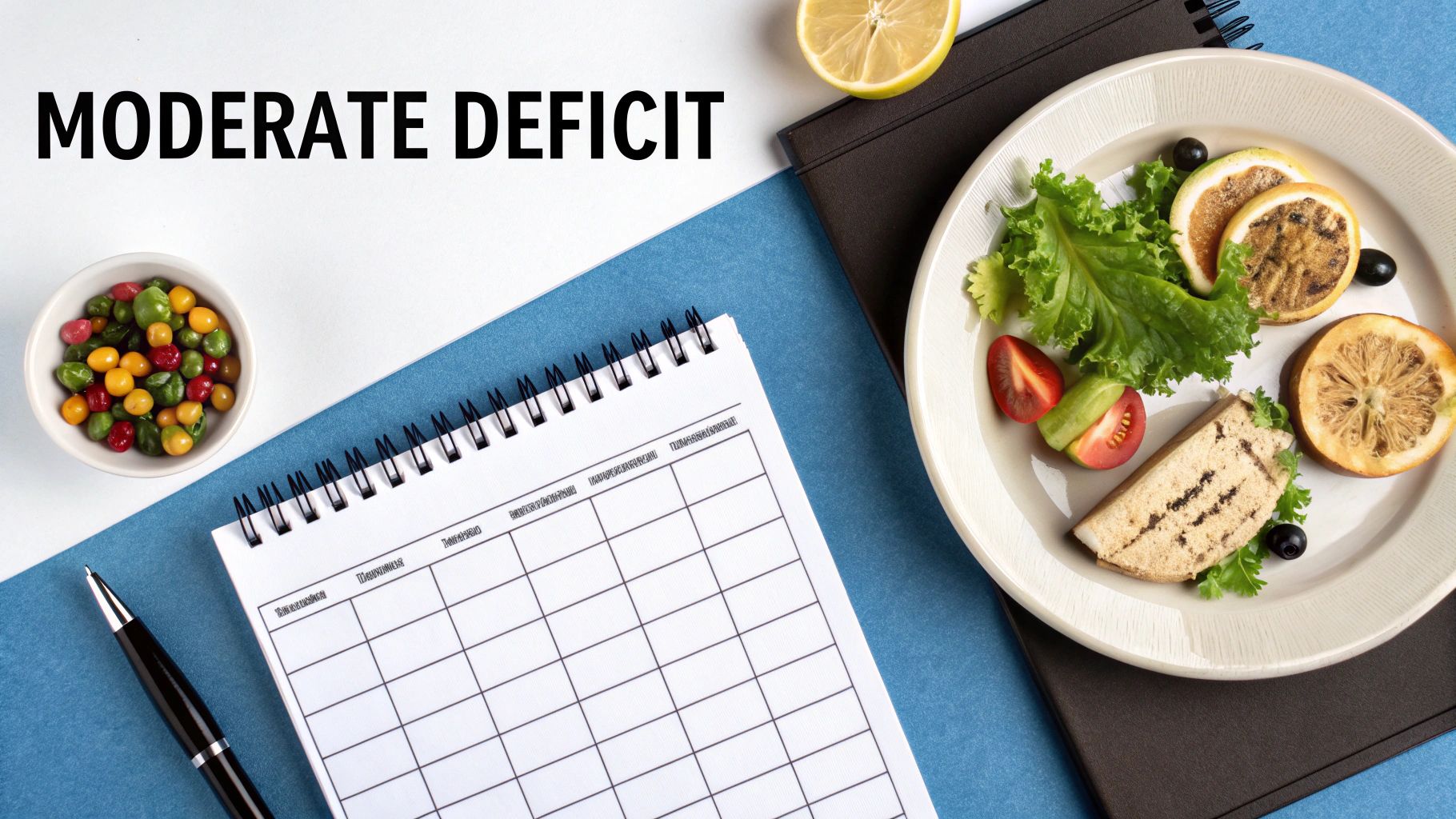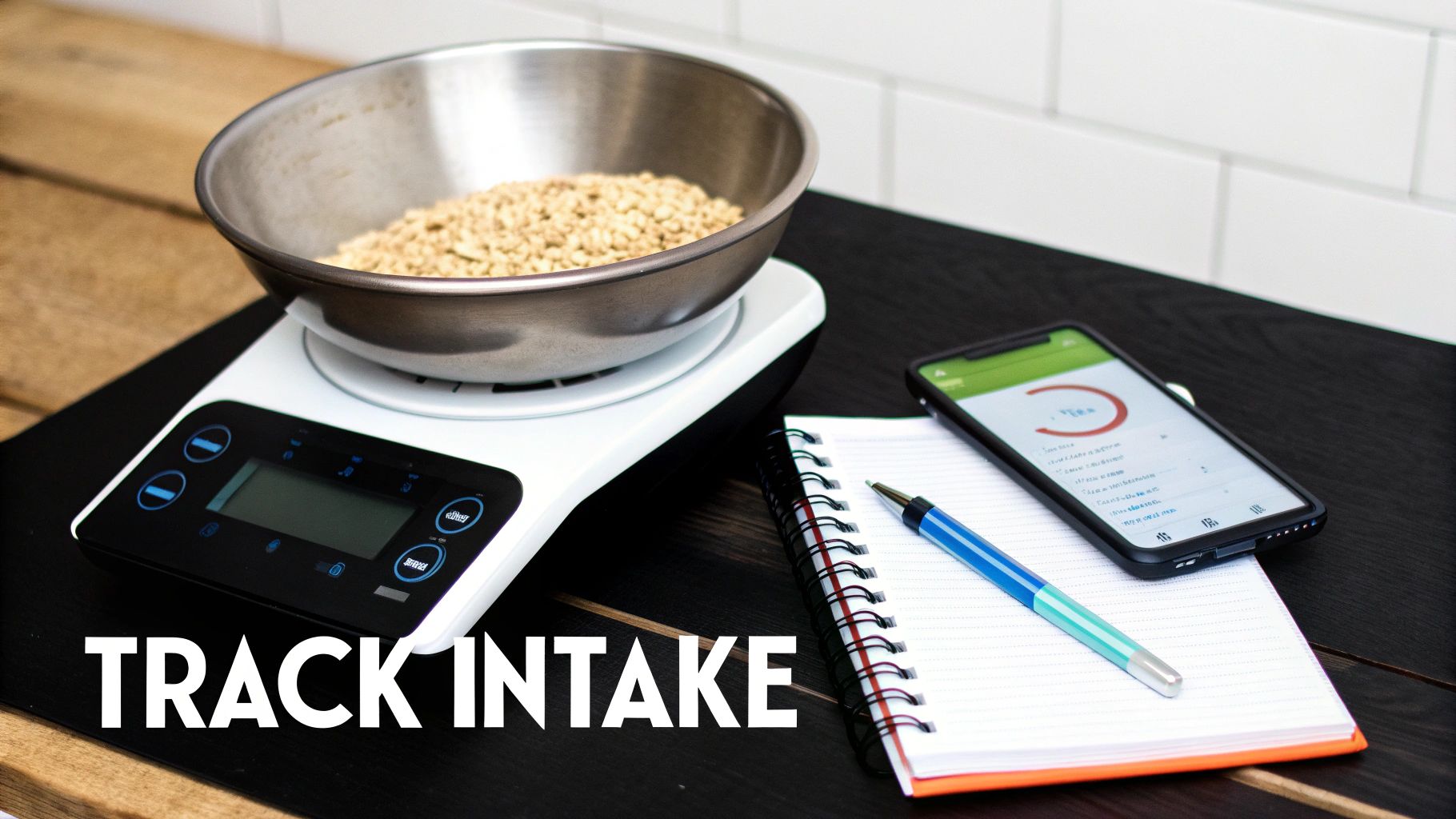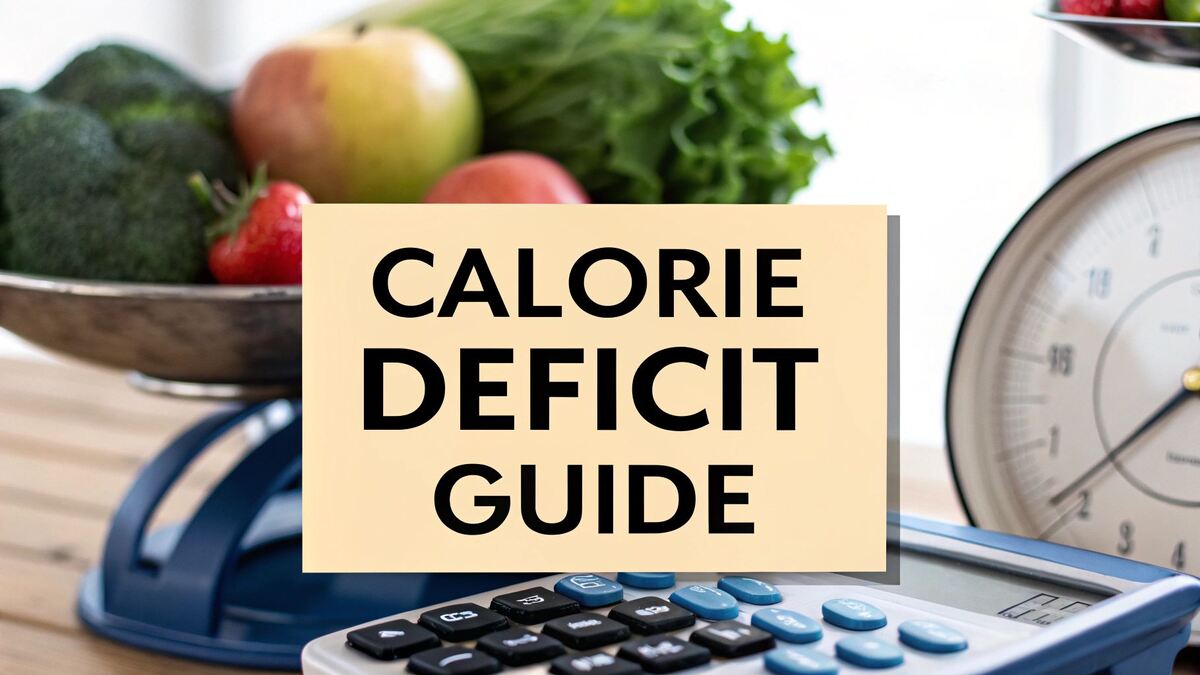How to Calculate Calorie Deficit for Real Results
Figuring out your personal calorie deficit isn't nearly as complicated as it sounds. The basic idea is to determine how much energy your body uses every day—your Total Daily Energy Expenditure (TDEE)—and then subtract a reasonable number of calories, usually between 300 to 500, to encourage steady weight loss. It's simply about consuming a little less energy than your body burns.
Your Starting Point for Finding a Calorie Deficit
Before you can cut anything, you need to know your baseline. This is your "maintenance" calorie number, which is the amount of energy your body needs just to stay at its current weight. Think of it as your daily energy budget.
To nail down that number, we'll look at two key metrics:
- Basal Metabolic Rate (BMR): This is the baseline energy your body needs just to exist. It’s the calories you burn at complete rest to keep essential functions like breathing, blood circulation, and cell production running.
- Total Daily Energy Expenditure (TDEE): This is the whole picture. It's your BMR plus all the calories you burn from daily activities—everything from a trip to the mailbox to a high-intensity workout.
The Best Formula for the Job
There are a few formulas out there, but I always recommend the Mifflin-St Jeor equation. It’s widely considered the gold standard by health professionals because it tends to be the most accurate for a wide range of people.
The whole concept of a "calorie deficit" has been around for over a century, but the science really started getting refined in the 1950s. The Mifflin-St Jeor equation, which came out in 1990, is still one of the most reliable tools we have today. For healthy, sustainable results, most experts suggest aiming for a deficit of around 500 calories per day. This pace typically leads to about one pound of fat loss per week, which is a great target.
Once you have your BMR number, you'll simply multiply it by an activity factor to get your TDEE. This is the personalized number that really matters, and it's the foundation for building a smart plan.
Your TDEE isn't just a number; it's the key that unlocks your ability to control your weight management journey. Getting it right from the start makes everything else fall into place.
From there, creating a deficit is straightforward. You’ll have a clear target, which takes the guesswork out of building a sustainable eating pattern—like what you'll find in our balanced meal plans—that actually helps you reach your goals.
Putting The Calorie Formulas Into Practice
All those formulas can seem a bit abstract on their own. The real "aha!" moment comes when you plug in the numbers and see how it works for a real person. Let's walk through an example from start to finish with a fictional person named Alex.
Meet Alex. She's a 35-year-old woman, stands 5'6" (168 cm) tall, and weighs 150 pounds (68 kg). She has a desk job, but she's pretty consistent about hitting the gym for a moderate workout about three times a week.
Calculating Alex's BMR
First things first, we need to figure out her Basal Metabolic Rate (BMR). This is the baseline—the calories her body burns just to keep the lights on. We'll use the Mifflin-St Jeor formula, which has proven to be more accurate than older methods like the Harris-Benedict equation.
Here’s the formula for women: BMR = 10 x weight (kg) + 6.25 x height (cm) – 5 x age (years) – 161
Let's plug in Alex's stats:
- BMR = (10 x 68) + (6.25 x 168) – (5 x 35) – 161
- BMR = 680 + 1050 – 175 – 161
- Alex’s BMR ≈ 1,394 calories per day
This infographic gives a great visual breakdown of how you get from BMR to your final deficit number.

As you can see, it all starts with your base metabolism and builds from there.
Finding Her Total Daily Energy Expenditure
Now, that 1,394 calorie BMR is just her resting metabolism. We need to account for her actual life—the desk job, errands, and those gym sessions. This is where her Total Daily Energy Expenditure (TDEE) comes in. Since she exercises 1-3 days a week, we'll use the "lightly active" multiplier of 1.375.
The math is simple: TDEE = BMR x Activity Multiplier
- TDEE = 1,394 x 1.375
- Alex’s TDEE ≈ 1,917 calories per day
This is the magic number. Alex's TDEE of 1,917 calories is her maintenance level. If she eats this much every day, her weight should stay exactly the same. You absolutely must know this number before you can create a deficit.
Getting a solid handle on how to calculate BMR is crucial because it’s the foundation for everything else. Once Alex knows her maintenance calories, she can confidently decide on a deficit.
Of course, the final piece of the puzzle is turning these numbers into actual meals. That’s where our AI Meal Planner can take over, creating delicious personalized meal plans that hit your new calorie target without you having to think about it.
How to Set a Sustainable Deficit for Weight Loss

Alright, we've figured out that Alex's maintenance number is 1,917 calories. Now comes the crucial part: creating a calorie deficit. This is exactly where a lot of people trip up. It's tempting to think that a bigger deficit means faster results, but slashing calories too drastically is a recipe for disaster. It can lead to muscle loss, nutrient deficiencies, and just plain burnout.
The real goal is to make a smart, sustainable adjustment that actually fits into your life.
Finding Your Sweet Spot
For long-term success, a conservative approach is almost always the best bet. For most people, this means subtracting somewhere between 300 to 500 calories from their TDEE. This range generally translates to a healthy and manageable weight loss of about 0.5 to 1 pound per week.
Let's see how this works for Alex:
- Alex's TDEE: 1,917 calories
- Sustainable Deficit: -500 calories
- New Daily Target: 1,417 calories
This new number, 1,417, is Alex's daily calorie goal for weight loss. It's a target that encourages fat loss while still giving her enough energy for her workouts and day-to-day activities. Think of it as a manageable adjustment, not an extreme diet.
Creating a sustainable deficit is all about finding a balance you can actually stick with. A 500-calorie reduction is a great starting point, but it's not a rigid rule. If you find yourself constantly hungry or exhausted, it might be smarter to adjust to a 300-calorie deficit. Listen to your body.
This sensible approach is what leads to lasting change. There's a reason the weight loss industry pulls in over $250 billion annually—quick fixes usually don't stick. In fact, clinical studies back this up, showing that while aggressive low-calorie diets can produce initial results, a significant amount of weight is often regained within a year, as detailed on Healthline.com.
To feel full and preserve muscle within this new calorie budget, protein is your best friend. Following a high-protein meal plan can make hitting your target feel much more satisfying and less like a chore. The key is to shift your mindset from restriction to strategic planning for your health.
Why Your Calorie Target Won't Last Forever
That initial calorie target that gets the scale moving? Don't get too attached to it. As you start shedding pounds, your body is changing in some pretty fundamental ways. A lighter body simply doesn't need as much fuel to get through the day, which means both your BMR and TDEE are going to drop.
This isn't a fluke; it's a completely normal biological process known as metabolic adaptation. Your body gets more efficient as it gets smaller, burning fewer calories both at rest and when you're working out. That's why the calorie deficit that worked like a charm for the first month can suddenly feel like it's not doing anything by month three. Welcome to the dreaded weight loss plateau.
Adjusting to Your New Normal
The trick is knowing when to make a change before you get stuck. If the scale hasn't budged for two or three weeks straight even though you’re sticking to the plan, that's your cue. It doesn't mean you've failed—it's just a sign that your body has adapted and is waiting for new instructions.
So, what do you do? It's time to recalculate. A good rule of thumb is to run the numbers again every time you lose 10-15 pounds. Just plug your new, lower weight into the BMR and TDEE formulas to find your updated maintenance level and set a new, effective deficit.
Think of it like adjusting the sails on a boat. As your body changes, you need to recalibrate to keep making progress. Staying on top of this is how you avoid getting stalled.
This need for ongoing adjustments is one of the main reasons long-term weight management is so tough. In fact, studies show that fewer than 20% of people manage to maintain their weight loss for over a year. Part of the challenge is that this metabolic slowdown can cut your daily energy needs by 5–15%.
This is exactly why knowing how to calculate your calorie deficit—and more importantly, how to recalculate it—is so critical for success. You can learn more about this dynamic process from the experts at American Sport & Fitness.
Practical Tools for Tracking Your Intake

Alright, you've done the math and have your target numbers. That’s a huge first step. But the real magic happens when you turn those numbers into daily action through consistent, accurate tracking. Without it, you’re just flying blind.
Your most powerful ally in this journey is a simple food scale. It's shockingly easy to underestimate portion sizes, especially with calorie-dense foods like nuts, oils, and cheeses. For instance, just one extra tablespoon of olive oil—which is almost impossible to eyeball correctly—can sneak in over 100 calories you never planned for. Weighing your food takes all the guesswork out of the equation.
Navigating Hidden Calories
Beyond weighing your main ingredients, you have to be a bit of a detective to spot the "hidden" calories that can easily sabotage your progress. These are the calories that often come from sources we don't think to track as carefully.
Pay close attention to these common culprits:
- Beverages: Your daily latte, that can of soda, or even "healthy" juices can pack hundreds of calories.
- Sauces and Dressings: That creamy ranch dressing or swirl of BBQ sauce adds up way faster than you think.
- Restaurant Meals: These are notoriously tricky. Chefs often use more butter and oil than you would at home, and portion sizes are usually much larger.
A crucial skill here is understanding food labels like a pro. Knowing how to quickly find serving sizes and calorie counts empowers you to make smarter choices on the fly, whether you're at the grocery store or logging a meal in an app.
Remember, tracking isn't about achieving perfection. It’s about building awareness and being consistent. The data you collect is feedback that helps you understand your habits and make small, effective adjustments along the way.
Calorie tracking apps are fantastic, but don't trust them blindly. Many rely on user-submitted entries, which can be inaccurate. If an entry in your app seems off, always take a second to cross-reference it with the product's actual nutrition label. A little diligence goes a long way in making sure your hard work truly pays off.
Answering Your Top Calorie Deficit Questions
Once you start crunching the numbers for your calorie deficit, a few questions inevitably pop up. I’ve seen them time and time again with clients. Getting these sorted out from the get-go will make your journey a whole lot smoother.
Let's dive into the most common ones.
So, How Fast Should the Weight Come Off?
Look, I get it. The temptation to drop weight as quickly as possible is real. But if you want results that actually stick, slow and steady is the name of the game. The gold standard for a reason is aiming to lose about 0.5 to 1 pound per week.
This pace is gentle enough that your body doesn’t hit the panic button, which can lead to gnawing hunger and feeling totally drained. More importantly, a gradual approach helps you hold onto your hard-earned muscle, meaning the weight you’re dropping is mostly fat.
Do I Really Need to Track Macros, Too?
While calories are king when it comes to weight loss, your macronutrients—protein, carbs, and fats—are the royal court. They play a huge supporting role. You don't have to become a slave to tracking every single gram, but if there's one thing you should pay attention to, it's protein.
Making protein a priority while you're in a deficit is a total game-changer for two big reasons:
- It keeps you full. Seriously, protein is incredibly satiating, which makes sticking to your calorie goal a thousand times easier.
- It protects your muscle. Your body needs protein to repair and maintain muscle tissue, which is absolutely vital for keeping your metabolism humming along.
A single day over your calorie goal isn't a disaster—it's just a blip on the radar. The real trap is falling into an "all-or-nothing" mindset. Just get back on track with your very next meal.
What Happens If I Go Over My Calorie Target?
First off, take a deep breath. It’s going to happen. You’re human. One day of enjoying a few extra calories won’t erase weeks of your hard work. The absolute worst thing you can do is try to compensate by drastically cutting calories the next day. That's a surefire recipe for a miserable binge-and-restrict cycle.
The best response? Just acknowledge it and move on. Return to your normal plan tomorrow. Remember, it's the consistency you bring over weeks and months that creates real change, not being perfect every single day.
Tired of guessing what to eat to hit your new goals? AI Meal Planner can build you a personalized plan with delicious meals that perfectly match your calorie deficit. Start your custom plan today!
AI-powered nutrition
Get Your Personalized Meal Plan
AI creates the perfect meals for your goals, lifestyle, and taste.
Start Your Journej
